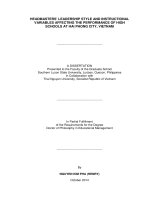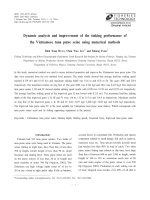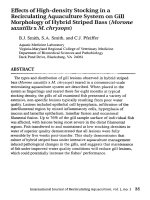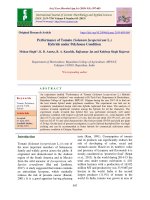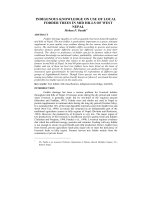Performance of hybrid fodder sorghum (Sugargraze)
Bạn đang xem bản rút gọn của tài liệu. Xem và tải ngay bản đầy đủ của tài liệu tại đây (181.39 KB, 6 trang )
Int.J.Curr.Microbiol.App.Sci (2020) 9(5): 1601-1606
International Journal of Current Microbiology and Applied Sciences
ISSN: 2319-7706 Volume 9 Number 5 (2020)
Journal homepage:
Original Research Article
/>
Performance of Hybrid Fodder Sorghum (Sugargraze)
Harphool Meena*, Pratap Singh, S. N. Meena, D. L. Yadav and N. L. Meena
Agricultural Research Station, Ummedganj Farm, Agriculture University,
Kota-324001 (Rajasthan), India
*Corresponding author
ABSTRACT
Keywords
Sugargraze, seed
rate, fodder yield,
quality
Article Info
Accepted:
15 April 2020
Available Online:
10 May 2020
A field experiment was conducted during two consecutive years from 2017
and 2018at Agricultural Research Station Ummedganj, Kota (Rajasthan),
sowing of hybrid fodder sorghum (sugargraze) by different seed rates viz.
3.5, 5.5,7.5, 9.5, 11.5 kg/ha and local chari 10.0 kg/ha. The fodder yield of
sugargraze was significantly influenced by sowing of different seed rate.
Pooled data of two years gave significantly higher green fodder yield(898
q/ha) and dry fodder yield (241 q/ha) were observed by sowing of
sugargraze 9.5 kg seed/ha over local chari sowing by 10.0 kg seed/ha green
fodder yield (659 q/ha) and dry fodder yield (166 q/ha). However, it was
found at par with sowing of sugargraze by 7.5 kg seed/ha green fodder
yield (887 q/ha) and dry fodder yield (238 q/ha).
Introduction
Sorghum [Sorghum bicolor (Linn.) Moench]
is an important crop in the world, used for
food (as grain or sorghum molasses), fodder,
the production of alcoholic beverages and
biofuels. Most varieties are drought and heat
tolerant, and are especially important in arid
regions, where the grain is one of the staple
food for poor and rural people. It is an
important food and fodder crop grown in
India, and among cereals, it is the fourth most
important crop after rice, wheat and maize
(Dehinwal et al., 2016). Sorghum grain is
used as staple food by millions of people and
is grown for grain in southern and central
states of India, whereas in northern states of
the country (Punjab, Haryana, Uttar Pradesh,
Rajasthan, etc.) it is mainly grown as fodder
during summer and kharif seasons as a single
as well as multicut crop. Among forage crops,
forage sorghum could be a strategic option
because
of
the
crop’s
xerophytic
characteristics, adaptation potential, quick
1601
Int.J.Curr.Microbiol.App.Sci (2020) 9(5): 1601-1606
growing habit, good ratoon ability,
palatability, digestibility and wide range of
potential uses as green fodder, dry roughage,
hay and silage (Kumar and Chaplot, 2015).
Among crop management practices seeding
densities or plant population greatly affect
crop growth and then finally grain yield.
Therefore seeding density is a key factor in
assessing the flexibility and yielding ability of
cultivars. Both over and substandard plant
population is the major cause of low yield
(Jan et al., 2000).
Optimum seed rate plays an important role in
contributing to the high yield because in case
of thick plant population, most plants remain
sterile, easily attacked by diseases as
compared to normal population(Robert and
Singh, 1981).To obtain high quality preserved
forage (silage or hay), harvest sugargraze at
knee height stage. For silage, let plants wilt
prior to ensiling and lower moisture content
will reduce effluent losses from silage. In the
India, two to three subsequent harvests are
possible. To stimulate recovery growth,
fertilize with nitrogen immediately following
the initial harvest (Smith et al., 2005).
followed by harrowing & cultivator and one
planking for uniform leveling , etc. were
performed for sowing of sugargraze crop.
Experiment was laid-out in Randomized
Block Design with four replications and six
treatments viz. T1: Sugargraze (seed rate 3.5
kg/ha), T2: Sugargraze (seed rate 5.5 kg/ha),
T3: Sugargraze (seed rate 7.5 kg/ha), T4:
Sugargraze (seed rate 9.5 kg/ha), T5:
Sugargraze (seed rate11.5 kg/ha) and T6:
Local chari (seed rate 10.0 kg/ha).
The bulk density, pH and cation exchange
capacity of these soils varies between 1.301.60 Mg/m3, 7.75-8.50 and 30-40 Cmol/kg,
respectively. The soils of the region are poor
in organic carbon (0.50±0.08) and available
nitrogen (275±5 kg/ha) but are low to medium
in available P2O5 (24.2± 1.0 kg/ha) and
medium to high in available K2O (290 ± 8
kg/ha).The recommended dose of nitrogen,
phosphorus & potash i.e.125 kg N/ha, 60 kg
P2O5 / ha and 60 kg K2O /ha were given in the
form of urea, di-ammonium phosphate (DAP)
and muriate of potash (MOP). Full dose of
DAP and MOP and half N were drilled just
before sowing and remaining half-N was
applied in two split doses as per
recommendation.
Materials and Methods
Results and Discussion
Field experiment was conducted during two
consecutive years from 2017 and 2018 at
Agricultural Research Station Ummedganj,
Kota. The research station is situated in AgroClimatic Zone V (Humid South-Eastern
Plain) of Rajasthan.
It is located between 25013´ N latitude and
750 25´ E longitudes at an altitude of 258 m
above MSL. The average rainfall of both the
years during crop growing season were 496.1
and 545 mm and means maximum and
minimum temperatures 34.6 & 37.1 0C and
16.9 & 20.60 C, respectively. Experimental
field was well prepared by two ploughing
First cutting
The plant population and growth parameters
of sugargraze were significantly influenced by
sowing of different seed rate (Table 1).
Pooled data of two years showed that the
significantly
higher
plant
population
(491765/ha) of sugargraze was recorded by
sowing of 11.5 kg seed/ha which was
significantly superior over rest of the
treatments. The maximum plant height
(153.51 cm) was recorded in the first cutting
by sowing of sugargraze by 3.5 kg seed/ha
over local chari plant height (131.98 cm).
1602
Int.J.Curr.Microbiol.App.Sci (2020) 9(5): 1601-1606
However, it was found at par with sowing of
sugargraze by 5.5 and 7.5 kg seed/ha. These
results are in close proximity with those of
Dehinwal et al., 2016, Smith et al., 2005 and
Jan et al., 2000. Two years data indicated that
the maximum leaf weight/plant (93.65 g) and
stem weight/plant (280.10 g) were recorded in
the first cutting of sugargraze by sowing 3.5
kg seed/ha but it was found at par with
sowing of sugargraze by 5.5 and 7.5 kg
seed/ha over local chari leaf weight/plant
(70.5 g) and stem weight/plant (214.05 g) by
sowing of 10 kg seed/ha in the pooled
analysis.
The higher leaf: stem ratio (0.37) was
observed in the pooled data of sugargraze by
sowing of 3.5 kg seed/ha over rest of the
treatments. These results are in close
proximity with those of Satpal et al., 2016,
Kumar and Chaplot (2015).
Pooled data of dry matter content was
significantly influenced by sowing of
different seed rate of sugargraze (Table 2).
Sowing of sugargraze by 9.5 kg seed/ha was
recorded maximum dry matter (26.70 %) but
it was found at par with the sowing of
sugargraze by 7.5 kg seed/ha over local chari
sowing by 10.0 kg seed/ha dry matter (26.53
%).
Significantly
influenced
quality
parameters of sugargraze by sowing of 9.5 kg
seed/ha, cruid protein (7.14) and cruid fibre
(24.90) per cent over local chari sowing by
10.0 kg seed/ha. However, it was found at par
with the sowing of different seed rate of
sugargraze 3.5,5.5,7.5 and 11.5 kg seed/ha,
respectively.
Two years pooled data indicated that
significantly influenced ash content (15.01)
per cent in sugargraze by sowing of 9.5 kg
seed/haover local chari (13.99) per cent
sowing by 10.0 kg seed/ha. These results are
in close proximity with those of Satpal et al.,
2016, Kumar and Chaplot (2015).
Second cutting
During second cutting plant growth was
significantly influenced (Table 3) by sowing
of different seed rate of sugargraze. The
maximum plant height (133 cm) of
sugargraze was recorded by sowing of 3.5 kg
seed/ha over local chari plant height(117 cm)
sowing by 10 kg seed/ha. However, it was
found at par with sowing of sugargraze by 5.5
and 7.5 kg seed/ha, respectively in the pooled
analysis.
The maximum leaf weight/ plant (66.17 g)
and stem weight/ plant (160.25 g) of
sugargraze were recorded by sowing of 3.5 kg
seed/ha over local chari leaf weight/ plant
(51.85 g) and stem weight/ plant (119.05 g)
by sowing of 10 kg seed/ha. However, it was
found at par with sowing of sugargraze by 5.5
and 7.5 kg seed/ha, respectively. Pooled data
of two years shows that the significantly
higher leaf: stem ratio (0.35) was observed by
sowing of sugargraze 3.5 kg seed/ha over rest
of the treatments. These results are in close
proximity with those of Dehinwal et al., 2016,
Smith et al., 2005 and Jan et al., 2000.
Significantly influenced dry matter (26.94)
per cent under sowing of sugargraze by 9.5 kg
seed/ha but it was found at par with the
sowing of sugargraze by 7.5 kg seed/hadry
matter (26.73) per cent over rest of treatments
(Table 4). Pooled data indicated that the
quality parameters of sugargraze cruid protein
(6.96) and cruid fibre (24.44) per cent were
significantly influenced by sowing of 9.5 kg
seed/ha over local chari sowing by 10.0 kg
seed/ha.
However, it was found at par with the sowing
of different seed rate of sugargraze 3.5,5.5,7.5
and 11.5 kg seed/ha, respectively. The
maximum ash content (14.94) per cent was
observed in sugargraze by sowing of 9.5 kg
seed/ha over local chari sowing by 10.0 kg
1603
Int.J.Curr.Microbiol.App.Sci (2020) 9(5): 1601-1606
seed/ha. However, it was found at par with
the sowing
of different seed rate of
sugargraze 3.5,5.5,7.5 and 11.5 kg seed/ha,
respectively in the pooled analysis. These
results are in close proximity with those of
Satpal et al., 2016, Kumar and Chaplot
(2015). Significantly higher green fodder
yield (898 q/ha) and dry fodder yield (241
q/ha) were observed with sowing of
sugargraze by 9.5 kg seed/ha over local chari
sowing by 10.0 kg seed/ha green fodder yield
(659 q/ha) and dry fodder yield (166 q/ha).
However, it was found at par with sowing of
sugargraze by 7.5 kg seed/ha green fodder
yield (887 q/ha) and dry fodder yield (238
q/ha). These results are in close proximity
with those of Satpal et al., 2016, Kumar and
Chaplot (2015).
Table.1 Pooled data of plant population, growth parameters, fodder yield and quality of
sugargraze during first cutting (2017 and 2018)
Treatments
T1: Sugargraze (seed rate 3.5
kg/ha)
T2: Sugargraze (seed rate 5.5
kg/ha)
T3: Sugargraze (seed rate 7.5
kg/ha)
T4: Sugargraze (seed rate 9.5
kg/ha)
T5: Sugargraze (seed rate 11.5
kg/ha)
T6: Local chari (seed rate 10.0
kg/ha)
SEm ±
CD at 5 %
Plant
population
(000/ha)
157440
Plant
height
(cm)
153.51
Weight
of leaves/
plant (g)
93.65
Weight
of stem/
plant (g)
280.10
Leaf : Stem
ratio
246240
152.39
92.65
279.45
0.36
329643
150.97
92.35
278.40
0.34
409765
142.23
91.25
275.55
0.33
491765
136.01
73.5
253.05
0.31
418000
131.98
70.5
214.05
0.26
1003
2906
1.10
2.80
0.67
1.92
1.15
3.34
0.002
0.008
0.37
Table.2 Pooled data of dry matter content and quality of sugargraze
during first cutting (2017 and 2019)
Treatments
T1: Sugargraze (seed rate 3.5
kg/ha)
T2: Sugargraze (seed rate 5.5
kg/ha)
T3: Sugargraze (seed rate 7.5
kg/ha)
T4: Sugargraze (seed rate 9.5
kg/ha)
T5: Sugargraze (seed rate 11.5
kg/ha)
T6: Local chari (seed rate 10.0
kg/ha)
SEm ±
CD at 5 %
Dry matter
(%)
Crude protein
(%)
Crude fibre
(%)
Ash content
(%)
27.62
7.15
24.88
15.05
26.72
7.16
24.85
15.03
26.71
7.17
24.89
15.03
26.70
7.14
24.90
15.01
25.99
7.11
24.86
14.95
26.53
6.37
23.36
13.97
0.11
0.36
0.037
0.105
0.15
0.45
0.03
0.09
1604
Int.J.Curr.Microbiol.App.Sci (2020) 9(5): 1601-1606
Table.3 Pooled data of plant growth parameters of sugargraze during second cutting
Treatments
T1: Sugargraze (seed rate 3.5 kg/ha)
Plant
height (cm)
133
Weight of
leaves/plant (g)
66.17
Weight of stem/
plant (g)
Pooled
Leaf : Stem
ratio
0.35
T2: Sugargraze (seed rate 5.5 kg/ha)
132
65.89
160.25
0.33
T3: Sugargraze (seed rate 7.5 kg/ha)
T4: Sugargraze (seed rate 9.5 kg/ha)
T5: Sugargraze (seed rate 11.5 kg/ha)
131
126
120
64.88
62.08
55.53
157.60
156.50
156.10
0.32
0.30
0.29
T6: Local chari (seed rate 10.0 kg/ha)
117
51.85
135.80
0.25
SEm ±
CD at 5 %
0.67
2.01
0.90
2.69
119.05
1.33
0.003
0.010
Table.4 Pooled data of fodder dry matter content and quality of sugargraze during second cutting
Treatments
T1: Sugargraze (seed rate 3.5 kg/ha)
Dry matter
(%)
25.14
Crude protein
(%)
6.97
Crude fibre
(%)
24.44
Ash content
(%)
14.98
T2: Sugargraze (seed rate 5.5 kg/ha)
25.63
6.99
24.44
14.97
T3: Sugargraze (seed rate 7.5 kg/ha)
T4: Sugargraze (seed rate 9.5 kg/ha)
T5: Sugargraze (seed rate 11.5 kg/ha)
26.73
26.94
25.05
6.99
6.96
6.80
24.46
24.44
24.46
14.96
14.94
14.91
T6: Local chari (seed rate 10.0 kg/ha)
22.64
5.97
23.00
13.95
SEm ±
CD at 5 %
0.18
0.52
0.024
0.067
0.077
0.23
0.063
0.18
Table.5 Pooled data of green fodder and dry fodder yield of sugargraze
during first and second cutting
Treatments
T1: Sugargraze (seed rate 3.5 kg/ha)
T2: Sugargraze (seed rate 5.5 kg/ha)
T3: Sugargraze (seed rate 7.5 kg/ha)
T4: Sugargraze (seed rate 9.5 kg/ha)
T5: Sugargraze (seed rate 11.5
kg/ha)
Green fodder yield
(q/ha)
Ist
IInd
Cutting
Cutting
382
244
421
260
556
331
564
334
514
262
Total
yield
(q/ha)
626
681
887
898
776
Dry fodder yield
(q/ha)
Ist
IInd
Cutting
Cutting
106
61
113
67
149
89
151
90
134
66
Total
yield
(q/ha)
167
180
238
241
200
T6: Local chari (seed rate 10.0
kg/ha)
409
250
659
109
57
166
SEm ±
3.58
2.68
-
1.00
0.59
-
CD at 5 %
10.41
7.77
-
2.90
1.69
-
1605
Int.J.Curr.Microbiol.App.Sci (2020) 9(5): 1601-1606
Sowing of sugargraze by 9.5 kg seed/ha gave
higher fodder yield over local chari sowing by
10.0 kg seed/ha. Sugargraze also recorded
better quality in term of cruid protein, cruid
fibre and ash and it may be suitable for green
fodder purpose.
References
Dehinwal, A. K., S. K. Pahuja and M.
Shafiqurrahaman, 2016. Environmental
effect on
sorghum fodder yield
and its related traits. Forage Res.42:
pp.189-194.
Jan, A., Kaleem, S.A., Taj, F.H. and Khan, H.
2000. Response of moongbean cultivars
to
different seeding densities at
dry land conditions. Pakistan J. Biol.
Sci.,3: 2030-32.
Kumar, D. and P. C. Chaplot. 2015.
Performance of multicut forage
sorghum genotypes to fertility levels.
Forage Res.41: 199-201.
Robert, W. and Singh, K. 1981. Food Grain,
A Text Book of Punjab Agriculture,
Civil and
Ministry
Gazette,
Lahore. 287.
Smith, H.J., B.M. Tast, H.Z. Taweet, S.
Tammingat and A. Elgersma, 2005.
Effect of
perennial
ryegrass
(Lolium perenne L.) cultivars on
herbage
production,
nutritional
quality and herbage intake of grazing
dairy cows. Grass and Forage
Science60: 297- 309.
Satpal, Dhun, B. S., Arya, S., PummyKumari
and Devi, S. 2016. Performance of
single cut
forage
sorghum
genotypes to different fertility levels.
Forage Res., 42:184-188.
How to cite this article:
Harphool Meena, Pratap Singh, S. N. Meena, D. L. Yadav and Meena. N. L. 2020. Performance
of Hybrid Fodder Sorghum (Sugargraze). Int.J.Curr.Microbiol.App.Sci. 9(05): 1601-1606.
doi: />
1606

